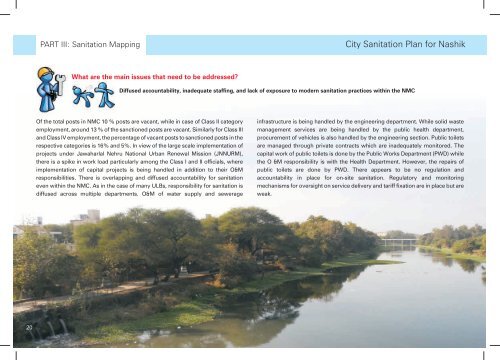City Sanitation Plan for Nashik - SuSanA
City Sanitation Plan for Nashik - SuSanA
City Sanitation Plan for Nashik - SuSanA
You also want an ePaper? Increase the reach of your titles
YUMPU automatically turns print PDFs into web optimized ePapers that Google loves.
PART III: <strong>Sanitation</strong> Mapping<br />
<strong>City</strong> <strong>Sanitation</strong> <strong>Plan</strong> <strong>for</strong> <strong>Nashik</strong><br />
What are the main issues that need to be addressed?<br />
Diffused accountability, inadequate staffing, and lack of exposure to modern sanitation practices within the NMC<br />
Of the total posts in NMC 10 % posts are vacant, while in case of Class II category<br />
employment, around 13 % of the sanctioned posts are vacant. Similarly <strong>for</strong> Class III<br />
and Class IV employment, the percentage of vacant posts to sanctioned posts in the<br />
respective categories is 16% and 5%. In view of the large scale implementation of<br />
projects under Jawaharlal Nehru National Urban Renewal Mission (JNNURM),<br />
there is a spike in work load particularly among the Class I and II officials, where<br />
implementation of capital projects is being handled in addition to their O&M<br />
responsibilities. There is overlapping and diffused accountability <strong>for</strong> sanitation<br />
even within the NMC. As in the case of many ULBs, responsibility <strong>for</strong> sanitation is<br />
diffused across multiple departments. O&M of water supply and sewerage<br />
infrastructure is being handled by the engineering department. While solid waste<br />
management services are being handled by the public health department,<br />
procurement of vehicles is also handled by the engineering section. Public toilets<br />
are managed through private contracts which are inadequately monitored. The<br />
capital work of public toilets is done by the Public Works Department (PWD) while<br />
the O &M responsibility is with the Health Department. However, the repairs of<br />
public toilets are done by PWD. There appears to be no regulation and<br />
accountability in place <strong>for</strong> on-site sanitation. Regulatory and monitoring<br />
mechanisms <strong>for</strong> oversight on service delivery and tariff fixation are in place but are<br />
weak.<br />
20
















